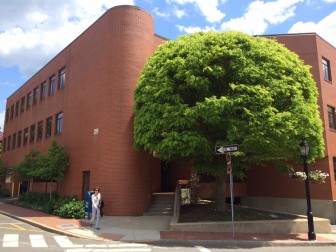Though the “alternative high school” is up and running in downtown New Canaan, town officials last week were prevented from approving a site plan that would formally allow it because of the district’s failure to properly notify neighboring property owners.

39 Locust Ave. Credit: Michael Dinan
The Planning & Zoning Commission must “give the public the opportunity next month to address” the district’s location of the alternative high school in 800 square feet of space on the second floor of the same building that New Canaan Public Schools administrators occupy on the corner of Forest Street and Locust Avenue, according to P&Z Chairman John Goodwin.
“This Commission’s responsibility is for use and land use and so, whether you like it or not, we are part of the checks and balances process of this town,” Goodwin told Superintendent of Schools Dr. Bryan Luizzi at the Commission’s regular meeting, held Sept. 25 at Town Hall.
Turning to his fellow commissioners, he added: “We cannot vote on this tonight, since notices did not go out in time. Normally we would not have opened the application, given the timing issues.”
Under the New Canaan Zoning Regulations, properties in the Retail B zone may be used as a “municipal facility,” including a school, with site plan approval by P&Z. Though school officials say they had been cleared health and fire safety officials to use the space at 39 Locust Ave. for instruction, P&Z at its August meeting flagged the district’s failure to obtain the required site plan approval.
As the applicant, the school district also is required to give nearby property owners 10 days’ notice prior to the P&Z hearing of its plan, under the regulations. Luizzi told the Commission that the district thought it was only seven days.
He apologized “for any confusion that may have come up with the process we are working through.”
At this point, Luizzi said, the district is not pursuing any significant interior alterations within the site plan itself.
“Initially our thinking was about any work that we were thinking of doing in the space to change the configuration from what was appropriate for a travel agency into what would make sense for an alternative high school program,” he said. “Thinking that since 39 Locust Ave. also houses an education program downstairs, in the LAUNCH program, we were not aware of the requirement to come to the Commission in order to talk about the actual use of the space, the zoning of the space. My apologies for any missteps along the way.”
(Though it did not come up at the public hearing, at the time the Board of Ed opened conversations with the town about what it needed to do in order to create the alternative high school on Locust Avenue, New Canaan’s well-regarded new town planner was not yet in place—only Keisha Fink, an interim who now works part-time in a support role.)
The alternative high school is designed to serve “students who are unsuccessful, for a variety of reasons, in the general day program we have,” Luizzi said. In the past, district officials have pointed to anxiety or other mental health challenges as qualifiers. At the alternative program, students work in a smaller, more flexible classroom environment with greater attention and additional professionals, including a social worker, on hand. In the past, some of those who are right for the alternative high school program had been served by the “Afternoon Instructional Program” or ‘AIP,’ which ran 4 to 5:30 p.m. Monday to Thursday. Currently, nine students and three educators are at the alternative high school, he said, and those students involved already are benefitting greatly from it.
Luizzi reviewed the program’s history. It emerged as a proposal during last budget season and the former Outback Teen Center was seen by some as a possible location for it. When municipal funding bodies rejected that proposal, district officials vowed to find another home for it.
P&Z Commissioners asked whether any interior alterations have been made (only painting and carpet), whether the district in carving out the alternative high school space is following state rules regarding students environments (yes), whether the district had opened up a room through some demolition as shown on a site plan (no), how students at the program come and go (some are driven and some take a bus) and where the bus drops off students (underneath the building, same as the LAUNCH program).
Noting that New Canaan runs five public schools, Commissioner John Kriz asked whether the alternative high school program couldn’t fit somewhere else the district’s buildings (the space on Locust Avenue is leased).
Luizzi responded that no space is available and that it’s important for such a program “to have its own identity.”